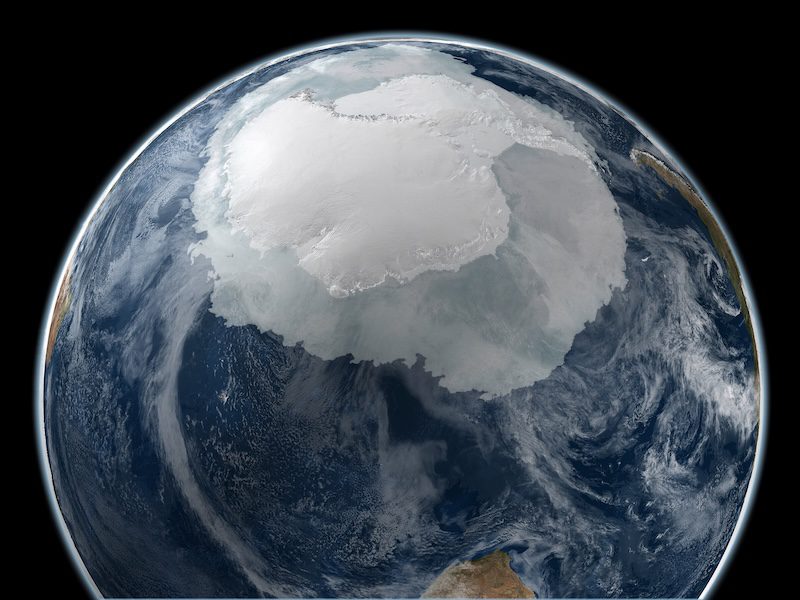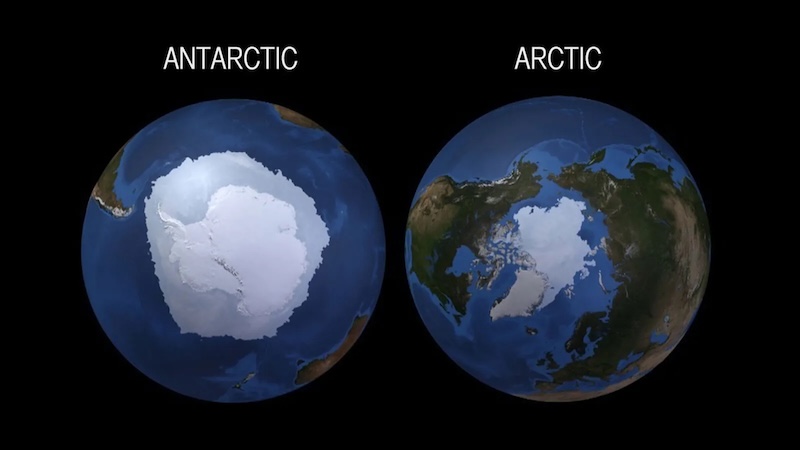
- Earth has two ice caps, the floating pack ice in the Arctic Ocean at the North Pole and the ice sheet covering Antarctica at the South Pole.
- How and why did the ice caps form? A new study suggests that Earth’s ice caps are not permanent. In fact, they are rare in Earth’s history.
- Multiple complex cooling processes need to occur at the same time for the ice caps to form as we see them today.
Are Earth’s ice caps temporary and rare?
Like the planet next door to us, Mars, Earth has ice caps at its North Pole and South Pole. The northern one floats on an ocean, and the southern one rests on land. But how did Earth’s ice caps form? And why do they exist at all? As it turns out, we just happen to live in a time when Earth’s ice caps exist. Researchers at the University of Leeds in the U.K. said on February 17, 2025, that ice caps are the rare result of various complex cooling processes that happened simultaneously. These scientists said that, for most of Earth’s history, the poles have been ice-free.
They said their findings provide clues about the future of Earth’s climate.
The researchers published their new peer-reviewed results in Science Advances on February 14, 2025.
Earth’s ice caps are rare
We’re so used to seeing Earth with its sparkling ice caps that it’s hard to imagine our world without them. But it turns out that we’re lucky to see them in our time. In fact, Earth hasn’t had them for the majority of its existence. Most of the time it was too warm. Scientists call this the “greenhouse” state. Ice caps have been rare in our planet’s history, occurring during colder periods, which scientists are still trying to understand.
So, why does Earth have ice caps now? What causes the colder periods? Is there one reason or multiple reasons? Scientists have proposed various possible explanations for Earth’s cold periods and resulting ice caps. These include decreased CO2 emissions from volcanoes, increased carbon storage by forests or the reaction of CO2 with certain types of rocks.
Now, the new study attempts to answer these questions.
? The cool conditions which allowed ice caps to form on Earth are rare events in the planet’s history and require many complex processes working at once, say #UniofAdelaide and @sydneyuni.bsky.social
— Australian Science Media Centre (@aussmc.bsky.social) 2025-02-17T04:21:01.569Z
Multiple complex processes
The researchers found the current existence of the ice caps is a result of various complex cooling processes happening at the same time. They used a new 3D model of Earth combining all the known cooling process over the long-term. They call it the Earth Evolution Model. Notably, the results suggested that Earth’s cooling periods were not the results of a single cooling process. Instead, multiple processes must be involved, occurring together.
Lead author Andrew Merdith at the University of Leeds at the time of the study (now at the University of Adelaide, Australia) explained:
We now know that the reason we live on an Earth with ice caps – rather than an ice-free planet – is due to a coincidental combination of very low rates of global volcanism and highly dispersed continents with big mountains, which allow for lots of global rainfall and therefore amplify reactions that remove carbon from the atmosphere.
The important implication here is that the Earth’s natural climate regulation mechanism appears to favor a warm and high-CO2 world with no ice caps, not the partially glaciated and low-CO2 world we have today. We think this general tendency towards a warm climate has helped prevent devastating ‘snowball Earth’ global glaciations, which have only occurred very rarely and have therefore helped life to continue to prosper.

Implications for the future
Not only do the results reveal important details about Earth’s history and current climate, they also provide clues about the future. Benjamin Mills at the University of Leeds supervised the study. He said:
There is an important message, which is that we should not expect the Earth to always return to a cold state as it was in the pre-industrial age. Earth’s current ice-covered state is not typical for the planet’s history, but our current global society relies on it. We should do everything we can to preserve it, and we should be careful with assumptions that cold climates will return if we drive excessive warming before stopping emissions. Over its long history, the Earth likes it hot, but our human society does not.
In addition, the findings are also interesting with respect to another study from 2022 that suggested ice on other Earth-like exoplanets would also be rare.
Bottom line: How and why did Earth’s ice caps form? A new study suggests they are a rare event in the planet’s history, the result of multiple coincidental cooling events.
Source: Phanerozoic icehouse climates as the result of multiple solid-Earth cooling mechanisms
Read more: Ice on Earth-like worlds might be rare
Read more: Why are Mars’ polar caps different from each other?
Source link
Read More
Visit Our Site
Read our previous article: Einstein Probe’s X-ray vision discovers an ‘impossible’ pair of vampire stars